|
|
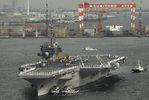
Yokosuka, Japan (Sept. 15, 2006) - Sailors man the rails of USS Kitty Hawk (CV 63) as the ship enters Truman Bay. Kitty Hawk completed a 99-day summer underway period, which including participating in Valiant Shield 2006.Yokosuka, Japan (Sept. 15, 2006) - Sailors man the rails of USS Kitty Hawk (CV 63) as the ship enters Truman Bay. Kitty Hawk completed a 99-day summer underway period, which including participating in Valiant Shield 2006, the largest joint Navy and Air Force exercise conducted since Operation Desert Storm. The Kitty Hawk Carrier Strike Group is the Navy's only overseas-based aircraft carrier. U.S. Navy photo by Mass Communication Specialist 3rd Class Jarod Hodge (RELEASED)
|
|

Yokosuka, Japan (Sept. 15, 2006) - Sailors man the rails of USS Kitty Hawk (CV 63) as the ship enters Truman Bay. Kitty Hawk completed a 99-day summer underway period.Yokosuka, Japan (Sept. 15, 2006) - Sailors man the rails of USS Kitty Hawk (CV 63) as the ship enters Truman Bay. Kitty Hawk completed a 99-day summer underway period, which including participating in Valiant Shield 2006, the largest joint Navy and Air Force exercise conducted since Operation Desert Storm. The Kitty Hawk Carrier Strike Group is the Navy's only overseas-based aircraft carrier. U.S. Navy photo by Mass Communication Specialist 3rd Class Jarod Hodge (RELEASED)
|
|
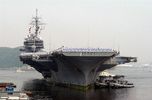
Yokosuka, Japan (May 6, 2003) -- USS Kitty Hawk (CV 63) returns to Yokosuka, Japan from her deployment to the Arabian Gulf. Yokosuka, Japan (May 6, 2003) -- USS Kitty Hawk (CV 63) returns to Yokosuka, Japan from her deployment to the Arabian Gulf. The Kitty Hawk Carrier Strike Group participated in Operations Southern Watch and Iraqi Freedom. Operation Iraqi Freedom is the multi-national coalition effort to liberate the Iraqi people, eliminate Iraq's weapons of mass destruction and end the regime of Saddam Hussein. U.S. Navy photo by Photographer's Mate 1st Class David A. Levy. (RELEASED)
|
|
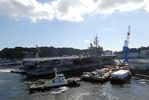
YOKOSUKA, Japan (Sept. 21, 2007) - USS Kitty Hawk (CV 63) pulls into her homeport o following a four-month summer deployment.YOKOSUKA, Japan (Sept. 21, 2007) - USS Kitty Hawk (CV 63) pulls into her homeport o following a four-month summer deployment. U.S. Navy photo by Mass Communication Specialist 2nd Class Andrew Meyers (RELEASED)
|
|
|
|

Yokosuka, Japan (Dec. 12, 2005) – Sailors assigned to Commander, Fleet Activities Yokosuka Port Operations, stand by as the conventionally powered aircraft carrier USS Kitty Hawk (CV 63) arrives after completing a regularly scheduled underway period.Yokosuka, Japan (Dec. 12, 2005) – Sailors assigned to Commander, Fleet Activities Yokosuka Port Operations, stand by as the conventionally powered aircraft carrier USS Kitty Hawk (CV 63) arrives after completing a regularly scheduled underway period. U.S. Navy photo by Photographer’s Mate 3rd Class Yesenia Rosas (RELEASED)
|
|
|
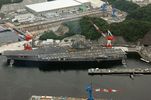
Yokosuka, Japan (June 8, 2006) - USS Kitty Hawk (CV 63) prepares to pull out of Truman Bay in Yokosuka, to begin its summer under way period in the western Pacific Ocean.Yokosuka, Japan (June 8, 2006) - USS Kitty Hawk (CV 63) prepares to pull out of Truman Bay in Yokosuka, to begin its summer under way period in the western Pacific Ocean. Kitty Hawk is the U.S. Navy's oldest active aircraft carrier. Currently under way in the 7th Fleet area of responsibility, Kitty Hawk demonstrates power, projection and sea control as the U.S. Navy's only permanently, forward-deployed aircraft carrier. U.S. Navy photo by Photographer's Mate 3rd Class Jarod R Hodge (RELEASED)
|
|
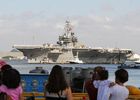
YOKOSUKA, Japan (Sept. 21, 2007) - Sailors man the rails as USS Kitty Hawk (CV 63) returns to Fleet Activities Yokosuka after a four-month summer deployment.YOKOSUKA, Japan (Sept. 21, 2007) - Sailors man the rails as USS Kitty Hawk (CV 63) returns to Fleet Activities Yokosuka after a four-month summer deployment. Kitty Hawk is the only permanently forward-deployed aircraft carrier in the Navy. U.S. Navy photo by Mass Communication Specialist Seaman Bryan Reckard (RELEASED)
|
|
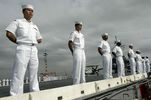
USS Kitty Hawk (CV 63) Sailors man the rails as the ship enters Truman Bay after completing a 99-day summer underway period which included port calls to Otaru, Japan.Yokosuka, Japan (Sept. 15, 2006) - USS Kitty Hawk (CV 63) Sailors man the rails as the ship enters Truman Bay after completing a 99-day summer underway period which included port calls to Otaru, Japan; Singapore; Perth, Australia; Laem Chabang, Thailand. Kitty Hawk also participated in Valiant Shield 2006, the largest joint Navy and Air Force exercise conducted since Operation Desert Storm. The Kitty Hawk Carrier Strike Group is the Navy's only overseas-based aircraft carrier. U.S. Navy photo by Mass Communication Specialist 3rd Class Jared Benner (RELEASED)
|
|

Yokosuka, Japan (Sept. 15, 2006) - Friends and family members hold a sign welcoming home Sailors aboard USS Kitty Hawk (CV 63), as they arrive at Commander, Fleet Activities Yokosuka.Yokosuka, Japan (Sept. 15, 2006) - Friends and family members hold a sign welcoming home Sailors aboard USS Kitty Hawk (CV 63), as they arrive at Commander, Fleet Activities Yokosuka, Japan. Kitty Hawk returned from a three-month deployment in the Seventh Fleet area of responsibility. U.S. Navy photo by Operations Specialist 2nd Class Kevin D. Harris (RELEASED)
|
|
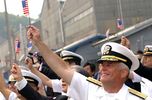
Yokosuka, Japan (May 6, 2003) -- Rear Adm. Robert C. Chaplin, Commander, U.S. Naval Forces Japan waives an American flag as the USS Kitty Hawk (CV 63) returns home from conducting operations in support of Operation Iraqi Freedom.Yokosuka, Japan (May 6, 2003) -- Rear Adm. Robert C. Chaplin, Commander, U.S. Naval Forces Japan waives an American flag as the USS Kitty Hawk (CV 63) returns home from conducting operations in support of Operation Iraqi Freedom. Operation Iraqi Freedom is the multi-national coalition effort to liberate the Iraqi people, eliminate Iraq's weapons of mass destruction and end the regime of Saddam Hussein. U.S. Navy photo by Photographer’s Mate 2nd Class Michael Damron. (RELEASED)
|
|

YOKOSUKA, Japan (Nov. 27, 2007) Family and friends celebrate the homecoming for USS Kitty Hawk (CV 63) as the ship arrives at Commander Fleet Activities Yokosuka.YOKOSUKA, Japan (Nov. 27, 2007) Family and friends celebrate the homecoming for USS Kitty Hawk (CV 63) as the ship arrives at Commander Fleet Activities Yokosuka. Kitty Hawk, the world's only permanently forward-deployed aircraft carrier, returned after completing a scheduled fall deployment and participation in ANNUALEX, the maritime component of the U.S.-Japan exercise Keen Sword 08. The exercise was designed to increase interoperability between the United States and JMSDF and enhance their ability to effectively and mutually respond to a regional crisis situation. U.S. Navy photo by Mass Communication Specialist Seaman Kari R. Bergman (Released)
|
|
|

Yokosuka, Japan (Aug. 20, 2005) - Sailors depart the conventionally powered aircraft carrier USS Kitty Hawk (CV 63) upon returning from a three-month regularly scheduled deployment.Yokosuka, Japan (Aug. 20, 2005) - Sailors depart the conventionally powered aircraft carrier USS Kitty Hawk (CV 63) upon returning from a three-month regularly scheduled deployment. Kitty Hawk demonstrates power projection and sea control as the U.S. Navy's only forward deployed aircraft carrier, operating out of Yokosuka, Japan. U.S. Navy photo by Photographer's Mate 3rd Class Jonathan B. Foutz (RELEASED)
|
|
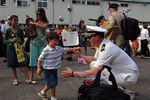
YOKOSUKA, Japan (Sept. 21, 2007) - Lt. Cmdr. Mark Evans prepares to hug his son after a four-month summer deployment aboard the USS Kitty Hawk (CV 63).YOKOSUKA, Japan (Sept. 21, 2007) - Lt. Cmdr. Mark Evans prepares to hug his son after a four-month summer deployment aboard the USS Kitty Hawk (CV 63). The ship took part in three major exercises during the deployment: Exercise Talisman Saber, Valiant Shield and Malabar. U.S. Navy photo by Mass Communication Specialist 3rd Class Dylan Butler (RELEASED)
|
|
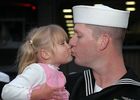
YOKOSUKA, Japan (Nov, 2007) Aviation Electronics Technician 1st Class Jason Sanders kisses his daughter after returning home from the aircraft carrier USS Kitty Hawk's (CV 63) fall deployment.YOKOSUKA, Japan (Nov, 2007) Aviation Electronics Technician 1st Class Jason Sanders kisses his daughter after returning home from the aircraft carrier USS Kitty Hawk's (CV 63) fall deployment. Kitty Hawk and the embarked Carrier Air Wing (CVW) 5 squadrons participated in exercise ANNUALEX with the Japan Maritime Self-Defense Force during the deployment. Kitty Hawk is the world's only permanently forward-deployed aircraft carrier and operates from Fleet Activities Yokosuka. U.S. Navy photo by Mass Communication Specialist 3rd Class Olivia Giger (Released)
|
|
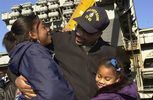
Yokosuka, Japan (December 23, 2001) -- Senior Chief Petty Officer Willie Harden is greeted by his two daughters after returning home aboard USS Kitty Hawk (CV 63).Command Fleet Activities, Yokosuka, Japan (December 23, 2001) -- Senior Chief Petty Officer Willie Harden is greeted by his two daughters after returning home aboard USS Kitty Hawk (CV 63). Kitty Hawk and its embarked carrier air wing five (CVW-5) returned home following months of sustained bombing missions in support of Operation Enduring Freedom. U.S. Navy Photo by Photographer’s Mate 2nd Class Jennifer A. Smith (Released)
|
|
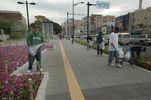
Sailors assigned to USS Kitty Hawk (CV 63) pick up trash on the streets of Yokosuka during a bi-monthly community service project. The 42 Kitty Hawk Sailors involved removed more than 30 bags of trash during a two-hour period.Yokosuka, Japan (April 7, 2006) - Sailors assigned to USS Kitty Hawk (CV 63) pick up trash on the streets of Yokosuka during a bi-monthly community service project. The 42 Kitty Hawk Sailors involved removed more than 30 bags of trash during a two-hour period. Currently in port, Kitty Hawk demonstrates power projection and sea control as the U.S. Navy's only forward-deployed aircraft carrier. U.S. Navy photo by Photographer's Mate Airman Joshua Wayne LeGrand (RELEASED)
|
|
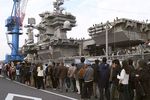
YOKOSUKA, Japan (Dec. 8, 2007) Thousands of Japanese visitors wait in line for a chance to tour America's only permanently forward-deployed aircraft carrier USS Kitty Hawk (CV 63) during the Grand Illumination, the first-ever holiday open base event.YOKOSUKA, Japan (Dec. 8, 2007) Thousands of Japanese visitors wait in line for a chance to tour America's only permanently forward-deployed aircraft carrier USS Kitty Hawk (CV 63) during the Grand Illumination, the first-ever holiday open base event held at Commander, Fleet Activities Yokosuka. Besides ship tours, visitYOKOSUKA, Japan (Dec. 8, 2007) Thousands of Japanese visitors wait in line for a chance to tour America's only permanently forward-deployed aircraft carrier USS Kitty Hawk (CV 63) during the Grand Illumination, the first-ever holiday open base event held at Commander, Fleet Activities Yokosuka. Besides ship tours, visitors were able to enjoy American fare, view the Festival of Trees and visit a few historical sites located on base, including an iron foundry monument and a few of the oldest dry docks in Japan. Open base events like this are designed to help strengthen the bond between the Japanese and U.S. Navy communities. U.S. Navy photo by Mass Communication Specialist 2nd Class Nardelito Gervacio (Released)ors were able to enjoy American fare, view the Festival of Trees and visit a few historical sites located on base, including an iron foundry monument and a few of the oldest dry docks in Japan. Open base events like this are designed to help strengthen the bond between the Japanese and U.S. Navy communities. U.S. Navy photo by Mass Communication Specialist 2nd Class Nardelito Gervacio (Released)
|
|
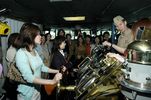
Yokosuka, Japan (April 21, 2006) - Cmdr. Donald Cuddington, Navigator of USS Kitty Hawk (CV 63), explains the function of Kitty Hawk's navigation bridge to members of the Japanese American Wives Association (JAWA).Yokosuka, Japan (April 21, 2006) - Cmdr. Donald Cuddington, Navigator of USS Kitty Hawk (CV 63), explains the function of Kitty Hawk's navigation bridge to members of the Japanese American Wives Association (JAWA). Tours of Kitty Hawk are conducted to increase public awareness of the aircraft carrier's mission and capabilities. Currently in port, Kitty Hawk demonstrates sea control and power projection as the U.S. Navy's only permanently forward-deployed aircraft carrier. U.S. Navy photo by Photographer's Mate Airman Jimmy C. Pan (RELEASED)
|
|
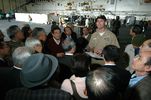
Kitty Hawk tours are often conducted to increase public awareness about the ship’s mission and her crew.Yokosuka, Japan (April 14, 2006) - USS Kitty Hawk (CV 63) Public Affairs Officer, Lt. Cmdr. Terry Dudley, provides an informational ship tour about to Japanese dignitaries. Kitty Hawk tours are often conducted to increase public awareness about the ship’s mission and her crew. Currently in port conducting repairs and maintenance during a ship's restricted availability period, Kitty Hawk demonstrates power projection and sea control as the U.S. Navy's only permanently forward-deployed aircraft carrier, operating from Yokosuka, Japan. U.S. Navy photo by Photographer's Mate Airman Adam York (RELEASED)
|
|

Yokosuka, Japan (Sept. 22, 2005) - Students from Ikego Elementary School, Japan, experience first-hand what it is like to live in ship's berthing during a tour aboard the conventionally powered aircraft carrier USS Kitty Hawk.Yokosuka, Japan (Sept. 22, 2005) - Students from Ikego Elementary School, Japan, experience first-hand what it is like to live in ship's berthing during a tour aboard the conventionally powered aircraft carrier USS Kitty Hawk (CV 63). During the tour the students visited the flight deck, forecastle, hangar bay and an unoccupied berthing area while learning about the life of Sailors aboard a U.S. Navy ship. U.S. Navy photo by Photographer's Mate Airman Matthew Reinhardt (RELEASED)
|
|
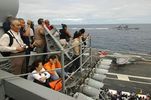
Yokosuka, Japan (Sept. 17, 2006) - Friends and family of USS Kitty Hawk (CV 63) Carrier Strike Group Sailors watch as an EA-6B Prowler from Electronic Warfare Squadron One three Six (VAQ-136), lands during a "Friends and Family Day" cruise.Yokosuka, Japan (Sept. 17, 2006) - Friends and family of USS Kitty Hawk (CV 63) Carrier Strike Group Sailors watch as an EA-6B Prowler from Electronic Warfare Squadron One three Six (VAQ-136), lands during a "Friends and Family Day" cruise. More than 2,200 family members and guests embarked aboard Kitty Hawk for a day cruise, which included an air power demonstration, shipboard tours and ship maneuvers by three warships of the Kitty Hawk Carrier Strike Group. U.S. Navy photo by Mass Communication Specialist Seaman Thomas J. Holt (RELEASED)
|
|
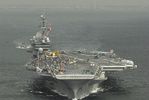
Yokosuka, Japan (Sept. 17, 2006) - Japanese guests and family members gather on the flight deck of USS Kitty Hawk (CV 63) to watch Sailors prepare for a flight demonstration during a family day cruise.Yokosuka, Japan (Sept. 17, 2006) - Japanese guests and family members gather on the flight deck of USS Kitty Hawk (CV 63) to watch Sailors prepare for a flight demonstration during a family day cruise. More than 2,200 family members and guests embarked aboard Kitty Hawk for a day cruise, which included an air power demonstration, shipboard tours and ship maneuvers by three warships of the Kitty Hawk Carrier Strike Group. U.S. Navy photo by Mass Communication Specialist 3rd Class Jarod Hodge (RELEASED)
|
|
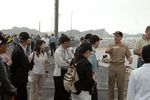
YOKOSUKA, Japan (Sept. 23, 2007) - Rear Adm. Jamie Kelly, commander of Naval Forces Japan, speaks to a tour group aboard USS Kitty Hawk (CV 63) during a Friends and Family Cruise.YOKOSUKA, Japan (Sept. 23, 2007) - Rear Adm. Jamie Kelly, commander of Naval Forces Japan, speaks to a tour group aboard USS Kitty Hawk (CV 63) during a Friends and Family Cruise. Kitty Hawk brought aboard more than 2,200 American and Japanese guests for a day cruise, which included an air demonstration and shipboard tours. U.S. Navy photo by Mass Communication Specialist 3rd Class Dylan Butler (RELEASED)
|
|
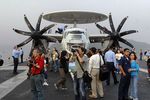
YOKOSUKA, Japan (Sept. 23, 2007) - Friends and family of Kitty Hawk Sailors tour the flight deck during a family day cruise. Kitty Hawk brought aboard more than 2,200 American and Japanese guests for a day cruise.YOKOSUKA, Japan (Sept. 23, 2007) - Friends and family of Kitty Hawk Sailors tour the flight deck during a family day cruise. Kitty Hawk brought aboard more than 2,200 American and Japanese guests for a day cruise, which included an air demonstration and shipboard tours. U.S. Navy photo by Mass Communication Specialist 3rd Class Dylan Butler (RELEASED)
|
|
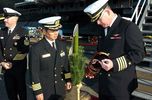
Yokosuka, Japan (Dec. 21, 2004) - Commanding officer of aircraft carrier USS Kitty Hawk (CV 63), Capt. Thomas Parker and commanding officer of Japanese Self-Defense Ship Shirane, Capt. Akira Aoki, participate in a traditional Japanese gift exchange.Yokosuka, Japan (Dec. 21, 2004) - Commanding officer of aircraft carrier USS Kitty Hawk (CV 63), Capt. Thomas Parker and commanding officer of Japanese Self-Defense Ship Shirane (DDH 143), Capt. Akira Aoki, participate in a traditional Japanese gift exchange. The crew of Shirane delivered two "Kadomatsu," which are traditional Japanese decorations of pine trees and bamboo, placed at the gates of houses and businesses during the New Year season. Kitty Hawk and Shirane are "sister ships" and participated in a variety of joint activities, helping to promote cultural relations and friendship between the United States and Japanese Navies. Currently in port, Kitty Hawk demonstrates power projection and sea control as the U.S. Navy's forward-deployed aircraft carrier, operating from Yokosuka, Japan. U.S. Navy photo by Photographer's Mate 3rd Class Tommy Paul Umholtz (RELEASED)
|
|

Yokosuka, Japan (June 10, 2004) - Fleet Activities Yokosuka Kinnick High School (KHS) conducts graduation ceremonies on the flight deck aboard USS Kitty Hawk (CV 63), with hundreds of family and friends in attendance.Yokosuka, Japan (June 10, 2004) - Fleet Activities Yokosuka Kinnick High School (KHS) conducts graduation ceremonies on the flight deck aboard USS Kitty Hawk (CV 63), with hundreds of family and friends in attendance. Ninty-six KHS Seniors received their diplomas during the ceremony, a first aboard an aircraft carrier. The historic event aboard America's oldest active warship was organized by the senior class in hopes of strengthening ties between KHS, Kitty Hawk and all of Fleet Activities Yokosuka. Kitty Hawk demonstrates power projection and sea control as the world's only permanently forward-deployed aircraft carrier, operating from Yokosuka, Japan. U.S. Navy photo by Photographer's Mate 3rd Class Lamel J. Hinton (RELEASED)
|
|

Yokosuka, Japan (June 10, 2004) - Graduating Seniors from Fleet Activities Yokosuka Kinnick High School (KHS) are transported to the ship's flight deck aboard USS Kitty Hawk (CV 63) on one of the aircraft elevators.Yokosuka, Japan (June 10, 2004) - Graduating Seniors from Fleet Activities Yokosuka Kinnick High School (KHS) are transported to the ship's flight deck aboard USS Kitty Hawk (CV 63) on one of the aircraft elevators, where they are greeted by more than 1,000 family members and friends for graduation ceremonies. Ninty-six KHS Seniors received their diplomas during the ceremony, a first aboard an aircraft carrier. The historic event aboard America's oldest active warship was organized by the senior class in hopes of strengthening ties between KHS, Kitty Hawk and all of Fleet Activities Yokosuka. Kitty Hawk demonstrates power projection and sea control as the world's only permanently forward-deployed aircraft carrier, operating from Yokosuka, Japan. U.S. Navy photo by Photographer's Mate 3rd Class Lamel J. Hinton (RELEASED)
|
|

Yokosuka, Japan (Feb. 21, 2007) – Vice President Dick Cheney speaks to a group of nearly 4,000 Japan-based military personnel, family members and Department of .civilian employees during a visit to USS Kitty HawkYokosuka, Japan (Feb. 21, 2007) – Vice President Dick Cheney speaks to a group of nearly 4,000 Japan-based military personnel, family members and Department of Defense civilian employees during a visit to USS Kitty Hawk (CV 63). During his speech, Cheney thanked the troops for their support of the global war on terrorism. Cheney is in Japan during a week-long tour to the Pacific to strengthen alliances with Japan and Australia. U.S. Navy photo by Mass Communication Specialist 1st Class Hana’lei Shimana (RELEASED)
|
|
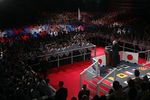
Yokosuka, Japan (Feb. 21, 2007) – Vice President Dick Cheney speaks to a group of nearly 4,000 Japan-based military personnel, family members and Department of Defense civilian employees.Yokosuka, Japan (Feb. 21, 2007) – Vice President Dick Cheney speaks to a group of nearly 4,000 Japan-based military personnel, family members and Department of Defense civilian employees during a visit to USS Kitty Hawk (CV 63). During his speech, Cheney thanked the troops for their support of the global war on terrorism. Cheney is in Japan during a week-long tour to the Pacific to strengthen alliances with Japan and Australia. U.S. Navy photo by Mass Communication Specialist Seaman Joseph A. Vernola
|
|
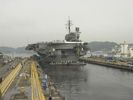
Yokosuka, Japan (May 20, 2003) -- USS Kitty Hawk (CV 63) is moved into dry dock at Fleet Activities Yokosuka for scheduled maintenance.Yokosuka, Japan (May 20, 2003) -- USS Kitty Hawk (CV 63) is moved into dry dock at Fleet Activities Yokosuka for scheduled maintenance. The carrier recently returned from operations with coalition forces in support of Operation Iraqi Freedom, the Persian Gulf during Operation Iraqi Freedom, the multi-national coalition effort to liberate the Iraqi people, eliminate Iraq's weapons of mass destruction, and end the regime of Saddam Hussein. U.S. Navy photo by Photographer’s Mate Airman Jacob Taylor. (RELEASED)
|
|

Yokosuka, Japan (May 20, 2003) -- The USS Kitty Hawk (CV 63) hull inspection team, assembled by the ship’s chief engineer, walks toward the screws of the Kitty Hawk.Yokosuka, Japan (May 20, 2003) -- The USS Kitty Hawk (CV 63) hull inspection team, assembled by the ship’s chief engineer, walks toward the screws of the Kitty Hawk. The team inspects the hull to assess how much maintenance may be required. Kitty Hawk is conducting scheduled maintenance at her forward-deployed operating location in Yokosuka, Japan. The carrier recently returned from operations with coalition forces in support of Operation Iraqi Freedom, the Persian Gulf during Operation Iraqi Freedom, the multi-national coalition effort to liberate the Iraqi people, eliminate Iraq's weapons of mass destruction, and end the regime of Saddam Hussein. U.S. Navy photo by Photographer’s Mate Airman Bo Flannigan. (RELEASED)
|
|

The team inspects the hull to assess how much maintenance may be required.Yokosuka, Japan (May 20, 2003) -- The USS Kitty Hawk (CV 63) hull inspection team, assembled by the ship’s chief engineer, walks toward the screws of the Kitty Hawk. The team inspects the hull to assess how much maintenance may be required. Kitty Hawk is conducting scheduled maintenance at her forward-deployed operating location in Yokosuka, Japan. The carrier recently returned from operations with coalition forces in support of Operation Iraqi Freedom, the Persian Gulf during Operation Iraqi Freedom, the multi-national coalition effort to liberate the Iraqi people, eliminate Iraq's weapons of mass destruction, and end the regime of Saddam Hussein. U.S. Navy photo by Photographer’s Mate Airman Bo Flannigan. (RELEASED)
|
|

Yokosuka, Japan (May 20, 2003) -- The USS Kitty Hawk (CV 63) hull inspection team, assembled by the ship’s chief engineer, walks toward the screws of the Kitty Hawk. The team inspects the hull to assess how much maintenance may be required. Kitty Hawk is conducting scheduled maintenance at her forward-deployed operating location in Yokosuka, Japan. The carrier recently returned from operations with coalition forces in support of Operation Iraqi Freedom, the Persian Gulf during Operation Iraqi Freedom, the multi-national coalition effort to liberate the Iraqi people, eliminate Iraq's weapons of mass destruction, and end the regime of Saddam Hussein. U.S. Navy photo by Photographer’s Mate Airman Bo Flannigan. (RELEASED)
|
|
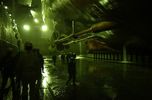
Yokosuka, Japan (May 20, 2003) -- The USS Kitty Hawk (CV 63) hull inspection team, assembled by the ship’s chief engineer, walks toward the screws of the Kitty Hawk. The team inspects the hull to assess how much maintenance may be required.Yokosuka, Japan (May 20, 2003) -- The USS Kitty Hawk (CV 63) hull inspection team, assembled by the ship’s chief engineer, walks toward the screws of the Kitty Hawk. The team inspects the hull to assess how much maintenance may be required. Kitty Hawk is conducting scheduled maintenance at her forward-deployed operating location in Yokosuka, Japan. The carrier recently returned from operations with coalition forces in support of Operation Iraqi Freedom, the Persian Gulf during Operation Iraqi Freedom, the multi-national coalition effort to liberate the Iraqi people, eliminate Iraq's weapons of mass destruction, and end the regime of Saddam Hussein. U.S. Navy photo by Photographer’s Mate 3rd Class William H. Ramsey. (RELEASED)
|
|

Yokosuka, Japan (Jul. 3, 2003) -- A Japanese National worker stands on one of USS Kitty Hawk's (CV 63) screws prior to its removal for maintenance.Yokosuka, Japan (Jul. 3, 2003) -- A Japanese National worker stands on one of USS Kitty Hawk's (CV 63) screws prior to its removal for maintenance. Kitty Hawk is currently undergoing scheduled maintenance at Naval Base Yokosuka ensuring its ability, to continue to maintain a responsible defensive posture in the Western Pacific region. U.S. Navy photo by Chief Photographer's Mate Jerry Woller. (RELEASED)
|
|

Yokosuka, Japan (Jul. 3, 2003) -- USS Kitty Hawk (CV 63) sits in dry dock undergoing repairs at Naval Base Yokosuka ensuring its ability, to continue to maintain a responsible defensive posture in the Western Pacific region.Yokosuka, Japan (Jul. 3, 2003) -- USS Kitty Hawk (CV 63) sits in dry dock undergoing repairs at Naval Base Yokosuka ensuring its ability, to continue to maintain a responsible defensive posture in the Western Pacific region. U.S. Navy photo by Chief Photographer's Mate Jerry Woller. (RELEASED)
|
|

Yokosuka, Japan (Aug. 26, 2003) -- Workers from Ship Repair Facility, Yokosuka, Japan, hoist freshly painted chain stoppers back into the forecastle aboard USS Kitty Hawk.Yokosuka, Japan (Aug. 26, 2003) -- Workers from Ship Repair Facility, Yokosuka, Japan, hoist freshly painted chain stoppers back into the forecastle aboard USS Kitty Hawk (CV 63). Kitty Hawk is currently undergoing an extensive scheduled maintenance cycle. Kitty Hawk is America's oldest active warship, and the worlds only permanently forward deployed aircraft carrier, operating out of Yokosuka, Japan. U.S. Navy photo by Photographer’s Mate Airman Bo Flannigan. (RELEASED)
|
|
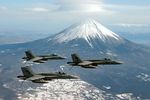
Yokosuka, Japan (Dec. 12, 2002) -- One of the first squadrons airborne to commemorate the F/A-18 program’s 5 millionth flight hour was Strike Fighter Squadron One Ninety Two (VFA-192) embarked aboard USS Kitty Hawk.Yokosuka, Japan (Dec. 12, 2002) -- One of the first squadrons airborne to commemorate the F/A-18 program’s 5 millionth flight hour was Strike Fighter Squadron One Ninety Two (VFA-192) embarked aboard USS Kitty Hawk (CV 63). The Kitty Hawk is the U.S. Navy’s only permanently forward-deployed aircraft carrier. U.S. Navy photo by Lt. Cmdr. William Koyama. (RELEASED)
|
|

MOUNT FUJI, Japan (April 12, 2007) - Aircraft assigned to Carrier Air Wing (CVW) 5 perform a formation flight in front of Mount Fuji.MOUNT FUJI, Japan (April 12, 2007) - Aircraft assigned to Carrier Air Wing (CVW) 5 perform a formation flight in front of Mount Fuji. CVW-5 is embarked aboard USS Kitty Hawk (CV 63). Kitty Hawk operates from Fleet Activities Yokosuka, Japan. U.S. Navy photo by Mass Communication Specialist 3rd Class Jarod Hodge (RELEASED)
|
|
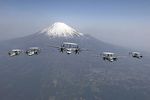
MOUNT FUJI, Japan (May 9, 2007) - E-2C Hawkeyes assigned to the "Liberty Bells," of Carrier Airborne Early Warning Squadron (VAW) 115 perform a formation flight in front of Mount Fuji.MOUNT FUJI, Japan (May 9, 2007) - E-2C Hawkeyes assigned to the "Liberty Bells," of Carrier Airborne Early Warning Squadron (VAW) 115 perform a formation flight in front of Mount Fuji. VAW-115 is one of the nine squadrons assigned Carrier Air Wing (CVW) Five, which is assigned to USS Kitty Hawk (CV 63). Kitty Hawk operates out of Fleet Activities Yokosuka, Japan. U.S. Navy photo by Mass Communication Specialist 3rd Class Jarod Hodge (RELEASED)
|
|
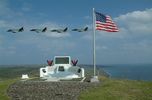
At sea with USS Kitty Hawk (CV 63) Jan. 16, 2003 -- F-14 Tomcats assigned to the Black Knights of Fighter Squadron One Five Four (VF-154) fly by Mt. Suribachi on Iwo Jima Island.At sea with USS Kitty Hawk (CV 63) Jan. 16, 2003 -- F-14 Tomcats assigned to the Black Knights of Fighter Squadron One Five Four (VF-154) fly by Mt. Suribachi on Iwo Jima Island. VF-154 is part of Carrier Air Wing Five (CVW-5) embarked aboard Kitty Hawk, conducting Carrier Readiness Certifications. Kitty Hawk is the NavyÕs only permanently forward-deployed aircraft carrier and operates out of Yokosuka, Japan. U.S. Navy photo by Lt. j.g. Greg Kausner. (RELEASED)
|
|
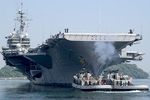
YOKOSUKA, Japan (May 4, 2007) - Large harbor tugs assist USS Kitty Hawk (CV 63) as she departs Commander Fleet Activities Yokosuka.YOKOSUKA, Japan (May 4, 2007) - Large harbor tugs assist USS Kitty Hawk (CV 63) as she departs Commander Fleet Activities Yokosuka. Kitty Hawk is getting underway to conduct sea trials after completing her Selective Restricted Availability (SRA). U.S. Navy photo by Mass Communication Specialist Seaman Kari R. Bergman (RELEASED)
|
|
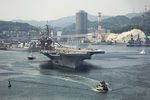
YOKOSUKA, Japan (May 15, 2007) - USS Kitty Hawk (CV 63) departs Fleet Activities Yokosuka to begin carrier qualifications in the western Pacific Ocean.YOKOSUKA, Japan (May 15, 2007) - USS Kitty Hawk (CV 63) departs Fleet Activities Yokosuka to begin carrier qualifications in the western Pacific Ocean. Kitty Hawk is the Navy's only permanent forward-deployed aircraft carrier and operates out of Yokosuka, Japan. U.S. Navy photo by Mass Communication Specialist Seaman Stephen Rowe (RELEASED)
|
|

Yokosuka, Japan (Oct. 17, 2006) - The aircraft carrier USS Kitty Hawk (CV 63) departs Yokosuka on a regularly scheduled deployment to the western Pacific Ocean.Yokosuka, Japan (Oct. 17, 2006) - The aircraft carrier USS Kitty Hawk (CV 63) departs Yokosuka on a regularly scheduled deployment to the western Pacific Ocean. The Kitty Hawk Carrier Strike Group, operates from the Navy's Fleet Activities in Yokosuka. U.S. Navy photo by Mass Communication Specialist Seaman Stephen Rowe (RELEASED)
|
|

Yokosuka, Japan (July 19, 2004) - USS Kitty Hawk (CV 63) departs Yokosuka Naval Base and prepares to transit the Tokyo Bay, to the Pacific Ocean.Yokosuka, Japan (July 19, 2004) - USS Kitty Hawk (CV 63) departs Yokosuka Naval Base and prepares to transit the Tokyo Bay, to the Pacific Ocean. The Kitty Hawk Strike Group is participating in Summer Pulse 2004, the simultaneous deployment of seven carrier strike groups (CSGs), demonstrating the ability of the Navy to provide credible combat across the globe, in five theaters with other U.S., allied, and coalition military forces. Summer Pulse is the Navy’s first deployment under its new Fleet Response Plan (FRP). U.S. Navy photo by Photographer’s Mate 2nd Class William H. Ramsey (RELEASED)
|
|
|
|
|
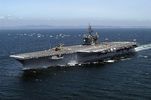
Yokosuka, Japan (May 17, 2005) – The conventionally powered aircraft carrier USS Kitty Hawk (CV 63) sails past a small group of Japanese fishing vessels and heads toward Sagami Bay to conduct precision anchor checks.Yokosuka, Japan (May 17, 2005) – The conventionally powered aircraft carrier USS Kitty Hawk (CV 63) sails past a small group of Japanese fishing vessels and heads toward Sagami Bay to conduct precision anchor checks during her post upkeep underway period in the western Pacific Ocean. Kitty Hawk is the U.S. Navy's oldest active aircraft carrier. Kitty Hawk demonstrates power projection and sea control as the U.S. Navy's only permanently forward-deployed aircraft carrier, operating from Yokosuka, Japan. U.S. Navy photo by Photographer's Mate 2nd Class William H. Ramsey (RELEASED)
|
|
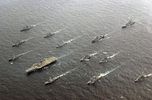
At sea with USS Kitty Hawk (CV 63) Nov. 15, 2002 -- The Kitty Hawk Battle Group align themselves to participate in a photo exercise.At sea with USS Kitty Hawk (CV 63) Nov. 15, 2002 -- The Kitty Hawk Battle Group align themselves to participate in a photo exercise. The photo exercise includes ships from the U.S. Navy and the Japan Maritime Self Defense Force (JMSDF) which are conducting exercises in support of Operation Keen Sword 2003. Kitty Hawk is the Navy’s only permanently forward-deployed aircraft carrier and operates out of Yokosuka, Japan. U.S. Navy photo by Photographer’s Mate 3rd Class Lee McCaskill. (RELEASED)
|
|
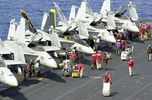
At sea aboard USS Kitty Hawk (CV 63) Apr. 24, 2002 -- Flight deck personnel prepare F/A-18 “Hornet” strike fighter aircraft for the next round of flight operations.At sea aboard USS Kitty Hawk (CV 63) Apr. 24, 2002 -- Flight deck personnel prepare F/A-18 “Hornet” strike fighter aircraft for the next round of flight operations. Kitty Hawk is providing a forward presence in the Asia-Pacific region, conducting training and exercises with its regional allies. Kitty Hawk is the Navy’s only permanently forward-deployed aircraft carrier operating out of Yokosuka, Japan. U.S. Navy photo by Photographer’s Mate 3rd Class John E. Wood. (RELEASED)
|
|

At sea aboard USS Kitty Hawk (CV 63) Mar. 19, 2002 -- Catapult and arresting Gear personnel assigned to V-2 division prepare catapult number two for the next day of Carrier Qualification (CQ).At sea aboard USS Kitty Hawk (CV 63) Mar. 19, 2002 -- Catapult and arresting Gear personnel assigned to V-2 division prepare catapult number two for the next day of Carrier Qualification (CQ). Kitty Hawk is conducting work-ups in preparation for an upcoming extended underway period, and is the Navy’s only permanently forward-deployed aircraft carrier, operating out of Yokosuka, Japan. U.S. Navy photo by Photographer's Mate 3rd Class John E. Woods. (RELEASED)
|
|

Central Command Area of Responsibility (Feb. 17, 2003) - An F/A-18C Hornet sits ready on catapult three, one of four steam-powered catapults aboard the aircraft carrier USS Kitty Hawk.Central Command Area of Responsibility (Feb. 17, 2003) - An F/A-18C Hornet sits ready on catapult three, one of four steam-powered catapults aboard the aircraft carrier USS Kitty Hawk (CV 63). Kitty Hawk and embarked Carrier Air Wing 5 remain mission-ready to respond to emergent national tasking where needed, and were recently ordered to the Central Command area of responsibility to join coalition forces preparing for possible operations in that area. Kitty Hawk is the U.S. Navy’s only permanently forward-deployed aircraft carrier and operates out of Yokosuka, Japan. U.S. Navy photo by Photographer’s Mate 3rd Class Todd Frantom. (RELEASED)
|
|
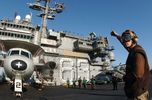
Arabian Gulf (Feb. 28, 2003) -- Airman Bena Videz from Albuquerque, N.M., assigned to the “Liberty Bells” of Carrier Airborne Early Warning Squadron One One Five signals to flight deck personnel “ready aircraft” after completing checks on an E2-C.Arabian Gulf (Feb. 28, 2003) -- Airman Bena Videz from Albuquerque, N.M., assigned to the “Liberty Bells” of Carrier Airborne Early Warning Squadron One One Five (VAW 115) signals to flight deck personnel “ready aircraft” after completing checks on an E2-C “Hawkeye.” Kitty Hawk and Carrier Air Wing Five (CVW-5) are operating with coalition forces in support of Operation Southern Watch and Enduring Freedom, and is the world’s only permanently forward-deployed aircraft carrier operating out of Yokosuka, Japan. U.S. Navy photo by Photographer’s Mate 3rd Class Todd Frantom. (RELEASED)
|
|

At sea aboard USS Kitty Hawk (CV 63) Nov. 14, 2002 -- Aviation Boatswain’s Mate 2nd Class Daniel Gadea from San Francisco, Calif., signals “ready shoot” before pushing the launch catapult button.At sea aboard USS Kitty Hawk (CV 63) Nov. 14, 2002 -- Aviation Boatswain’s Mate 2nd Class Daniel Gadea from San Francisco, Calif., signals “ready shoot” before pushing the launch catapult button. Petty Officer Gadea’s job is to launch aircraft once the signal is given from the “shooter.” Kitty Hawk is the Navy’s only permanently forward-deployed aircraft carrier and operates out of Yokosuka, Japan. U.S. Navy photo by Photographer’s Mate 3rd Class Todd Frantom. (RELEASED)
|
|
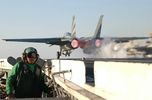
Arabian Gulf (Feb. 28, 2003) -- An F-14A “Tomcat” launches from one of four stream powered catapults aboard the aircraft carrier USS Kitty Hawk (CV 63).Arabian Gulf (Feb. 28, 2003) -- An F-14A “Tomcat” launches from one of four stream powered catapults aboard the aircraft carrier USS Kitty Hawk (CV 63). Kitty Hawk and Carrier Air Wing Five (CVW-5) are operating with coalition forces in support of Operation Southern Watch and Enduring Freedom, and is the world’s only permanently forward-deployed aircraft carrier operating out of Yokosuka, Japan. U.S. Navy photo by Photographer’s Mate 3rd Class Todd Frantom. (RELEASED)
|
|
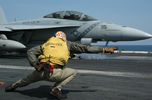
7th Fleet Area of Responsibility (AOR) Mar. 21, 2004 - An F/A-18F Super Hornet assigned to the “Diamondbacks” of Strike Fighter Squadron One Zero Two (VFA-102) launches past Lt. Cmdr. Mark W. Kekeisen, of St. Louis, Mo., as it speed its way down.7th Fleet Area of Responsibility (AOR) Mar. 21, 2004 - An F/A-18F Super Hornet assigned to the “Diamondbacks” of Strike Fighter Squadron One Zero Two (VFA-102) launches past Lt. Cmdr. Mark W. Kekeisen, of St. Louis, Mo., as it shuttles its way down USS Kitty Hawk’s (CV 63) flight deck before becoming airborne. Kitty Hawk is currently underway in the 7th Fleet area of responsibility (AOR), and is the U.S. Navy’s only permanently forward-deployed aircraft carrier, operating from Yokosuka, Japan. U.S. Navy photo by Photographer’s Mate 3rd Class Jason T. Poplin. (RELEASED)
|
|
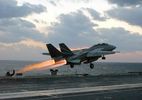
At sea aboard USS Kitty Hawk (CV 63) Nov. 14, 2002 -- An F-14 “Tomcat” assigned to the “Black Knights” of Fighter Squadron One Five Four (VF-154) launches past steaming catapults on the bow of the ship.At sea aboard USS Kitty Hawk (CV 63) Nov. 14, 2002 -- An F-14 “Tomcat” assigned to the “Black Knights” of Fighter Squadron One Five Four (VF-154) launches past steaming catapults on the bow of the ship. After an aircraft launches, steam is released as catapult pressure subsides. Kitty Hawk is the Navy’s only permanently forward-deployed aircraft carrier and operates out of Yokosuka, Japan. U.S. Navy photo by Photographer’s Mate 3rd Class Todd Frantom. (RELEASED)
|
|
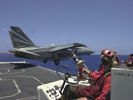
At sea aboard USS Kitty Hawk (Mar. 26, 2002) -- The Flight Deck Crash and Salvage crew stands by in case of any emergencies during flight operations.At sea aboard USS Kitty Hawk (Mar. 26, 2002) -- The Flight Deck Crash and Salvage crew stands by in case of any emergencies during flight operations. Kitty Hawk is currently conducting work-ups in preparation for an upcoming extended underway period. Kitty Hawk is the Navy’s only permanently forward deployed aircraft carrier and homeported in Yokosuka, Japan. U.S. Navy photo by Photographer's Mate 3rd Class John E. Woods. (RELEASED)
|
|

At sea aboard USS Kitty Hawk (CV 63) Mar. 19, 2002 -- An F-14 “Tomcat” Fighter assigned to the “Black Knights” from Fighter Squadron One Five Four (VF-154) comes in for an arrested recovery during flight operations.At sea aboard USS Kitty Hawk (CV 63) Mar. 19, 2002 -- An F-14 “Tomcat” Fighter assigned to the “Black Knights” from Fighter Squadron One Five Four (VF-154) comes in for an arrested recovery during flight operations. Kitty Hawk is conducting work-ups in preparation for an upcoming extended underway period, and is the Navy’s only permanently forward-deployed aircraft carrier, operating out of Yokosuka, Japan. U.S. Navy photo by Photographer's Mate 3rd Class John E. Woods. (RELEASED)
|
|
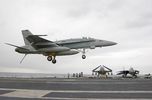
At sea with USS Kitty Hawk (CV 63) Jan. 24, 2003 -- An F/A-18C “Hornet,” with its tailhook down, attempts a controlled landing on the ship’s flight deck.At sea with USS Kitty Hawk (CV 63) Jan. 24, 2003 -- An F/A-18C “Hornet,” with its tailhook down, attempts a controlled landing on the ship’s flight deck. Kitty Hawk is the Navy’s only permanently forward-deployed aircraft carrier and operates out of Yokosuka, Japan. U.S. Navy photo by Photographer’s Mate 3rd Class Todd Frantom. (RELEASED)
|
|
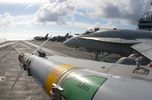
At sea aboard USS Kitty Hawk (CV 63) Feb. 17, 2003 -- An F/A-18C “Hornet”, armed with the AIM-9M Sidewinder missile, stands ready for launch.At sea aboard USS Kitty Hawk (CV 63) Feb. 17, 2003 -- An F/A-18C “Hornet”, armed with the AIM-9M Sidewinder missile, stands ready for launch. The Sidewinder missile is a short-range, heat seeking, air-intercept missile, used by 28 different nations including the United States. Kitty Hawk and her embarked Carrier Air Wing Five (CVW-5) are in the Indian Ocean with coalition forces in that area. Kitty Hawk is the Navy’s only permanently forward-deployed aircraft carrier and operates out of Yokosuka, Japan. U.S. Navy photo by Photographer’s Mate 3rd Class Todd Frantom. (RELEASED)
|
|

At sea aboard USS Kitty Hawk (CV 63) November 27, 2001 – After 58 days of sustained round the clock combat operations, crewmembers let off some steam and enjoy a “swim-call” during a break in flight operations.At sea aboard USS Kitty Hawk (CV 63) November 27, 2001 – After 58 days of sustained round the clock combat operations, crewmembers let off some steam and enjoy a “swim-call” during a break in flight operations. Kitty Hawk and her embarked Carrier Air Wing Five (CVW-5) are conducting missions in support of Operation Enduring Freedom. Kitty Hawk operates out of Yokosuka, Japan, as America's only permanently forward-deployed aircraft carrier. U.S. Navy Photo by Photographer's Mate 3rd Class Christopher S. Borgren II (Released)
|
|
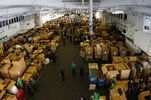
Pacific Ocean (Sept. 6, 2004) – Squadron personnel assigned to Carrier Air Wing Five (CVW-5) stage equipment and supplies in the hangar bay.Pacific Ocean (Sept. 6, 2004) – Squadron personnel assigned to Carrier Air Wing Five (CVW-5) stage equipment and supplies in the hangar bay aboard the conventionally powered aircraft carrier USS Kitty Hawk (CV 63) in preparation of their offload and transfer back to Naval Air Facility Atsugi, Japan. CVW-5 makes up approximately 40 percent of the 5,300 Sailors aboard Kitty Hawk while under way. Kitty Hawk, the U. S. Navy's only permanently forward-deployed aircraft carrier, returned Sept. 7 from its summer underway period, to its operating port of Yokosuka, Japan. U.S. Navy photo by Photographer's Mate Airman Jason D. Landon (RELEASED)
|
|
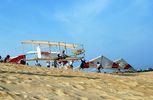
Jockey's Ridge State Park, N.C. (Oct. 3, 2002) -- Lt. Cmdr. Klas "Santa" Ohman, from aboard USS Kitty Hawk (CV 63), completes a flight in a replica of the 1902 Wright brothers' glider.Jockey's Ridge State Park, N.C. (Oct. 3, 2002) -- Lt. Cmdr. Klas "Santa" Ohman, from aboard USS Kitty Hawk (CV 63), completes a flight in a replica of the 1902 Wright brothers' glider. Ohman, one of only three military pilots with the honor to fly the aircraft, will do so during the commemorative event "Return to Kitty Hawk," scheduled for the first weekend in October. The 1902 Wright glider was the first aircraft incorporating yaw, pitch, and roll controls, and considered by most aviation historians to be a significant milestone in aviation history. USS Kitty Hawk is the United States' only permanently forward deployed aircraft carrier, operating out of Yokosuka, Japan. The replica is built by the Wright Brothers' Aeroplane Company, an educational organization established to further the interests of young people in aviation careers. U.S. Navy photo by Photographer's Mate 1st Class Shane T. McCoy. (RELEASED)
|
|
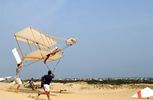
Ohman, one of only three military pilots with the honor to fly the aircraft, will do so during the commemorative event "Return to Kitty Hawk," scheduled for the first weekend in October.Jockey's Ridge State Park, N.C. (Oct. 3, 2002) -- Lt. Cmdr. Klas "Santa" Ohman stationed aboard USS Kitty Hawk (CV 63), completes a flight in a replica of the 1902 Wright brothers' glider. Ohman, one of only three military pilots with the honor to fly the aircraft, will do so during the commemorative event "Return to Kitty Hawk," scheduled for the first weekend in October. The 1902 Wright glider was the first aircraft incorporating yaw, pitch, and roll controls, and considered by most aviation historians to be a significant milestone in aviation history. USS Kitty Hawk is the United States' only permanently forward deployed aircraft carrier, operating out of Yokosuka, Japan. The replica is built by the Wright Brothers' Aeroplane Company, an educational organization established to further the interests of young people in aviation careers. U.S. Navy photo by Photographer's Mate 1st Class Shane T. McCoy. (RELEASED)
|
|

Arabian Gulf (Mar. 17, 2003) -- An F/A-18C Hornet assigned to the “Royal Maces” of Strike Fighter Squadron Two Seven (VFA-27) is moved to the flight deck on the starboard-forward aircraft elevator.Arabian Gulf (Mar. 17, 2003) -- An F/A-18C Hornet assigned to the “Royal Maces” of Strike Fighter Squadron Two Seven (VFA-27) is moved to the flight deck on the starboard-forward aircraft elevator, one of four aboard USS Kitty Hawk (CV 63). Kitty Hawk and her embarked Carrier Air Wing Five (CVW-5) are conducting combat missions in support of Operations Southern Watch and Enduring Freedom. Kitty Hawk is the Navy’s only permanently forward-deployed aircraft carrier and operates out of Yokosuka, Japan. U.S. Navy photo by Photographer's Mate 3rd Class Todd Frantom. (RELEASED)
|
|
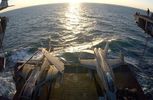
Arabian Gulf (Feb. 28, 2003) -- An EA-6B “Prowler” (left) and an F/A-18C “Hornet” (right) are raised to the flight deck on one of four aircraft elevators aboard USS Kitty Hawk (CV 63).Arabian Gulf (Feb. 28, 2003) -- An EA-6B “Prowler” (left) and an F/A-18C “Hornet” (right) are raised to the flight deck on one of four aircraft elevators aboard USS Kitty Hawk (CV 63). Kitty Hawk and Carrier Air Wing Five (CVW-5) are conducting missions in support of Operation Southern Watch. Approaching 42 years of distinguished service, Kitty Hawk is America’s oldest active commissioned vessel and is the Navy’s only permanently forward-deployed aircraft carrier operating from Yokosuka, Japan. Kitty Hawk is in the 5th Fleet area of operations in support of coalition forces in that region. U.S. Navy photo by Photographer’s Mate 3rd Class Todd Frantom. (RELEASED)
|
|
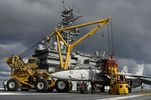
Pacific Ocean (Jan. 13, 2005) - Crash-and-salvage personnel rig a training skeleton of an F-14 Tomcat to "Tilly," a mobile crane used aboard USS Kitty Hawk (CV 63).Pacific Ocean (Jan. 13, 2005) - Crash-and-salvage personnel rig a training skeleton of an F-14 Tomcat to "Tilly," a mobile crane used aboard USS Kitty Hawk (CV 63). Tilly is used to move damaged aircraft off the flight line during crash and salvage operations. Kitty Hawk's crash-and-salvage team serves as the ship's flight deck firefighting crew. Currently conducting sea trials in the western Pacific Ocean, Kitty Hawk demonstrates power projection and sea control as the U.S. Navy's only permanently forward-deployed aircraft carrier, operating from Yokosuka, Japan. U.S. Navy photo by Photographer's Mate 3rd Class Bo Flannigan (RELEASED)
|
|
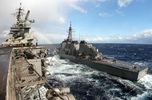
At sea aboard USS Kitty Hawk (CV 63) Dec. 10, 2002 -- Sailors aboard the Japanese Maritime Self Defense Force (JMSDF) ship Chokai (DDF 176) come along side the Kitty Hawk to receive fuel during a replenishment at sea (RAS).At sea aboard USS Kitty Hawk (CV 63) Dec. 10, 2002 -- Sailors aboard the Japanese Maritime Self Defense Force (JMSDF) ship Chokai (DDF 176) come along side the Kitty Hawk to receive fuel during a replenishment at sea (RAS). Kitty Hawk had the opportunity to work with the JMSDF during exercises conducted earlier in the deployment. Kitty Hawk is the U. S. Navy’s only forward-deployed aircraft carrier and operates out of Yokosuka, Japan. U.S. Navy photo by Photographer’s Mate 3rd Class Todd Frantom. (RELEASED)
|
|
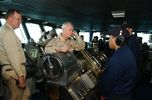
Arabian Gulf (Mar. 1, 2003) -- Vice Adm. Timothy Keating, Commander, U.S. Naval Force Central Command, tours the bridge of the aircraft carrier USS Kitty Hawk (CV 63) while meeting with Sailors aboard ship.Arabian Gulf (Mar. 1, 2003) -- Vice Adm. Timothy Keating, Commander, U.S. Naval Force Central Command, tours the bridge of the aircraft carrier USS Kitty Hawk (CV 63) while meeting with Sailors aboard ship. Kitty Hawk and her embarked Carrier Air Wing Five (CVW-5) are conducting missions in support Operation Southern Watch and Enduring Freedom. Kitty Hawk and its embarked Carrier Air Wing Five (CVW-5) is the world’s only permanently forward-deployed aircraft carrier and operates out of Yokosuka, Japan. U.S. Navy photo by Photographer’s Mate 3rd Class William H. Ramsey. (RELEASED)
|
|
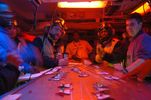
Sea of Japan (Mar. 20, 2005) - Flight Deck Officer, Lt. Adrian Turner, center, monitors the movement of aircraft from Flight Deck Control during night flight operations.Sea of Japan (Mar. 20, 2005) - Flight Deck Officer, Lt. Adrian Turner, center, monitors the movement of aircraft from Flight Deck Control during night flight operations aboard the conventionally powered aircraft carrier USS Kitty Hawk (CV 63). The Kitty Hawk Carrier Strike Group is currently participating in the joint exercises Reception, Staging, Onward movement, and Integration (RSO&I) and Foal Eagle. RSO&I is a complex multi-phase exercise conducted annually, tailored to train, test, and demonstrate United States and Republic of Korea force projection and deployment capabilities. Foal Eagle exercise runs simultaneously and trains in all aspects of Combined Forces Command's mission. The defensive Naval Foal Eagle exercises began Mar. 19, 2005 with eight U.S. Navy ships from the USS Kitty Hawk (CV 63) Carrier Strike Group. Kitty Hawk demonstrates power projection and sea control as the U.S. Navy's only permanently forward-deployed aircraft carrier, operating from Yokosuka, Japan. U.S. Navy photo by Photographer's Mate 3rd Class Bo Flannigan (RELEASED)
|
|
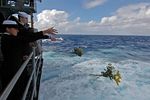
CORAL SEA (July 26, 2007) - Yeoman Seaman Jessica Gardner and Yeoman Seaman Whitney Utter throw flowers overboard as USS Kitty Hawk (CV 63) passes the final resting place of USS Lexington.CORAL SEA (July 26, 2007) - Yeoman Seaman Jessica Gardner and Yeoman Seaman Whitney Utter throw flowers overboard as USS Kitty Hawk (CV 63) passes the final resting place of USS Lexington (CV 2). The ship passed the spot where 216 Lexington Sailors lost their lives after their ship on was attacked by Japanese forces on May 8, 1942, during the battle of Coral Sea. Kitty Hawk is two months into her summer deployment from Fleet Activities Yokosuka, Japan. U.S. Navy photo by Mass Communication Specialist Seaman Kyle D. Gahlau (RELEASED)
|
|
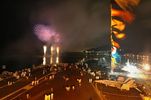
Otaru, Japan (July 4, 2006) - Fireworks burst off the coast of Otaru, during a 4th of July celebration for the officers and Sailors of the Kitty Hawk (CV 63) Carrier Strike Group. Otaru, Japan (July 4, 2006) - Fireworks burst off the coast of Otaru, during a 4th of July celebration for the officers and Sailors of the Kitty Hawk (CV 63) Carrier Strike Group. Visitors from the Otaru area were invited aboard to join in an Independence Day reception, which included food, drinks and music. While in port Sailors will have a chance to sightsee, shop, enjoy recreational activities and participate in community relation projects. Currently in port, Kitty Hawk demonstrates power projection and sea control as the U.S. Navy's only forward-deployed aircraft carrier. U.S. Navy photo by Mass Communication Specialist Seaman Thomas J. Holt (RELEASED)
|
|
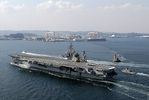
YOKOSUKA, Japan (March 7, 2008) The aircraft carrier USS Kitty Hawk (CV 63) enters Truman Bay after completing sea trials.YOKOSUKA, Japan (March 7, 2008) The aircraft carrier USS Kitty Hawk (CV 63) enters Truman Bay after completing sea trials. U.S. Navy photo by Mass Communication Specialist 3rd Class Kyle D. Gahlau (Released)
|
|
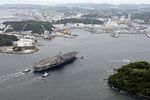
YOKOSUKA, Japan (May 12, 2008) The aircraft carrier USS Kitty Hawk (CV 63) enters Yokosuka, Japan's Truman Bay after completing its last deployment before being replaced by the aircraft carrier USS George Washington (CVN 73) this summer.YOKOSUKA, Japan (May 12, 2008) The aircraft carrier USS Kitty Hawk (CV 63) enters Yokosuka, Japan's Truman Bay after completing its last deployment before being replaced by the aircraft carrier USS George Washington (CVN 73) this summer. During the four-week deployment, the ship worked with the aircraft carrier USS Nimitz (CVN 68). Kitty Hawk operates from Fleet Activities Yokosuka. U.S. Navy photo by Mass Communication Specialist 3rd Class Kyle D. Gahlau (Released)
|
|

The aircraft carrier USS Kitty Hawk (CV 63) enters Truman Bay after completing its last deployment before being replaced this summer by the nuclear-powered aircraft carrier USS George Washington (CVN 73).YOKOSUKA, Japan (May 12, 2008) The aircraft carrier USS Kitty Hawk (CV 63) enters Truman Bay after completing its last deployment before being replaced this summer by the nuclear-powered aircraft carrier USS George Washington (CVN 73). U.S. Navy photo by Mass Communication Specialist 3rd Class Kyle D. Gahlau (Released)
|
|
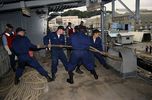
Aboard USS Kitty Hawk (CV 63) Oct. 13, 2003 -- Boatswain’s Mates from Deck Department’s 3rd division heave in mooring lines during USS Kitty Hawk’s (CV 63) departure for sea trials.Aboard USS Kitty Hawk (CV 63) Oct. 13, 2003 -- Boatswain’s Mates from Deck Department’s 3rd division heave in mooring lines during USS Kitty Hawk’s (CV 63) departure for sea trials. The aircraft carrier recently completed an extensive five-month maintenance period in Yokosuka, Japan, following her deployment in support of Operation Iraqi Freedom. U.S. Navy photo by Photographer’s Mate 3rd Class Jason R. Williams. (RELEASED)
|
|

YOKOSUKA, Japan (Dec. 5, 2007) A Carrier Airborne Early Warning Squadron (VAW) 115 E-2C Hawkeye is lowered onto the pier from the flight deck of the aircraft carrier USS Kitty Hawk (CV 63).YOKOSUKA, Japan (Dec. 5, 2007) A Carrier Airborne Early Warning Squadron (VAW) 115 E-2C Hawkeye is lowered onto the pier from the flight deck of the aircraft carrier USS Kitty Hawk (CV 63). The aircraft was moved to a barge and will be returned to Naval Air Facility Atsugi, Japan, in the next few days. U.S. Navy photo by Mass Communication Specialist 3rd Class Jimmy C. Pan (Released)
|
|
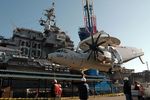
The aircraft was moved to a barge and will be returned to Naval Air Facility Atsugi, Japan, in the next few days. YOKOSUKA, Japan (Dec. 5, 2007) A Carrier Airborne Early Warning Squadron (VAW) 115 E-2C Hawkeye is lowered onto the pier from the flight deck of the aircraft carrier USS Kitty Hawk (CV 63). The aircraft was moved to a barge and will be returned to Naval Air Facility Atsugi, Japan, in the next few days. U.S. Navy photograph by Mass Communication Specialist 3rd Class Jimmy C. Pan (Released)
|
|
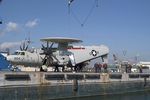
Sailors and Japanese contractors work together to secure an E-2C Hawkeye to a barge for transport to Naval Air Facility Atsugi for repairs.YOKOSUKA, Japan (Dec. 5, 2007) USS Kitty Hawk (CV 63) Sailors and Japanese contractors work together to secure an E-2C Hawkeye to a barge for transport to Naval Air Facility Atsugi for repairs. The E-2C Hawkeye is the U.S. Navy's all-weather, carrier-based tactical airborne warning and control system platform. Kitty Hawk is the only permanently forward-deployed aircraft carrier in the Navy and operates from Yokosuka, Japan. U.S. Navy photo by Mass Communication Specialist 2nd Class Nardelito Gervacio (Released)
|
|
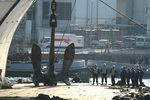
Yokosuka, Japan (Jan. 16, 2007) - Deck department Sailors stand clear of the starboard anchor of USS Kitty Hawk (CV 63) as it is lowered onto a barge.Yokosuka, Japan (Jan. 16, 2007) - Deck department Sailors stand clear of the starboard anchor of USS Kitty Hawk (CV 63) as it is lowered onto a barge. The anchor was being removed so regular maintenance could be performed on the detachable links. Kitty Hawk has two anchors weighing 30 tons each. The length of anchor chain is 1,080 feet and each link weighs 360 pounds. U.S. Navy photo by Mass Communication Specialist 3rd Class Juan Antoine King (RELEASED)
|
|
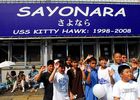
YOKOSUKA, Japan (May 28, 2008) Students from Yokosuka Middle School wave goodbye to the aircraft carrier USS Kitty Hawk (CV 63) as the ship departs Fleet Activities Yokosuka for the last time.YOKOSUKA, Japan (May 28, 2008) Students from Yokosuka Middle School wave goodbye to the aircraft carrier USS Kitty Hawk (CV 63) as the ship departs Fleet Activities Yokosuka for the last time. Kitty Hawk, the Navy's oldest active warship and only forward-deployed aircraft carrier, will soon be relieved by the Nimitz-class nuclear-powered aircraft carrier USS George Washington (CVN 73). U.S. Navy photo by Mass Communication Specialist 3rd Class Matthew R. White (Released)
|
|

Rear Adm. Richard Wren, commander of Carrier Strike Group (CSG) 5, speaks before the aircraft carrier USS Kitty Hawk (CV 63) makes her final departure from Commander Fleet Activities Yokosuka.YOKOSUKA, Japan (May 28, 2008) Rear Adm. Richard Wren, commander of Carrier Strike Group (CSG) 5, speaks before the aircraft carrier USS Kitty Hawk (CV 63) makes her final departure from Commander Fleet Activities Yokosuka. Kitty Hawk, the Navy's oldest active warship and only forward-deployed aircraft carrier, will soon be relieved by the Nimitz-class nuclear-powered aircraft carrier USS George Washington (CVN 73). U.S. Navy photo by Mass Communication Specialist 3rd Class Matthew R. White (Released)
|
|

Sailors man the rails of the aircraft carrier USS Kitty Hawk (CV 63) as the ship departs Fleet Activities Yokosuka for the last time.YOKOSUKA, Japan (May 28, 2008) Sailors man the rails of the aircraft carrier USS Kitty Hawk (CV 63) as the ship departs Fleet Activities Yokosuka for the last time. Kitty Hawk, the Navy's oldest active warship and only forward-deployed aircraft carrier, will soon be relieved by the Nimitz-class nuclear-powered aircraft carrier USS George Washington (CVN 73). U.S. Navy photo by Mass Communication Specialist 3rd Class Matthew R. White (Released)
|
|

Students from Yokosuka Middle School hold up a sign honoring the aircraft carrier USS Kitty Hawk (CV 63) as the ship prepares to depart Fleet Activities Yokosuka for the last time.YOKOSUKA, Japan (May 28, 2008) Students from Yokosuka Middle School hold up a sign honoring the aircraft carrier USS Kitty Hawk (CV 63) as the ship prepares to depart Fleet Activities Yokosuka for the last time. Kitty Hawk, the Navy's oldest active warship and only forward-deployed aircraft carrier, will soon be relieved by the Nimitz-class nuclear-powered aircraft carrier USS George Washington (CVN 73). U.S. Navy photo by Mass Communication Specialist 3rd Class Matthew R. White (Released)
|
|

Kianna and Koben Hill say goodbye to their father, Lt. Dane Hill and the aircraft carrier USS Kitty Hawk (CV 63) during the ship's departure from Fleet Activities Yokosuka.YOKOSUKA, Japan (May 28, 2008) Kianna and Koben Hill say goodbye to their father, Lt. Dane Hill and the aircraft carrier USS Kitty Hawk (CV 63) during the ship's departure from Fleet Activities Yokosuka. Kitty Hawk, the Navy's oldest active warship and only forward-deployed aircraft carrier, will soon be relieved by the Nimitz-class nuclear-powered aircraft carrier USS George Washington (CVN 73). U.S. Navy photo by Mass Communication Specialist Seaman John J. Mike (Released)
|
|

A young man waves the American Flag as the aircraft carrier USS Kitty Hawk (CV 63) prepares to depart Fleet Activities Yokosuka for the last time. YOKOSUKA, Japan (May 28, 2008) A young man waves the American Flag as the aircraft carrier USS Kitty Hawk (CV 63) prepares to depart Fleet Activities Yokosuka for the last time. Kitty Hawk, the Navy's oldest active warship and only forward-deployed aircraft carrier, will soon be relieved by the Nimitz-class nuclear-powered aircraft carrier USS George Washington (CVN 73). U.S. Navy photo by Mass Communication Specialist 3rd Class Matthew R. White (Released)
|
|

The aircraft carrier USS Kitty Hawk departs its forward-deployed operating base of Yokosuka, Japan for the last time. Kitty Hawk is the oldest active warship and the only conventional-powered aircraft carrier in the Navy. YOKOSUKA, Japan (May 28, 2008) The aircraft carrier USS Kitty Hawk departs its forward-deployed operating base of Yokosuka, Japan for the last time. Kitty Hawk is the oldest active warship and the only conventional-powered aircraft carrier in the Navy. Kitty Hawk will be replaced by the nuclear-powered aircraft carrier USS George Washington (CVN 73). U.S. Navy photo by Mass Communication Specialist 2nd Class Shawn Cole (Released)
|
|

Kitty Hawk, the Navy's oldest active warship and only forward-deployed aircraft carrier, will soon be relieved by the Nimitz-class nuclear-powered aircraft carrier USS George Washington (CVN 73).YOKOSUKA, Japan (May 28, 2008) Sailors man the rails of the aircraft carrier USS Kitty Hawk (CV 63) as the ship departs Fleet Activities Yokosuka for the last time. Kitty Hawk, the Navy's oldest active warship and only forward-deployed aircraft carrier, will soon be relieved by the Nimitz-class nuclear-powered aircraft carrier USS George Washington (CVN 73). U.S. Navy photo by Mass Communication Specialist 3rd Class Matthew R. White (Released)
|
|
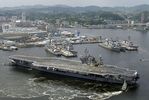
The aircraft carrier USS Kitty Hawk (CV 63) departs Yokosuka, Japan for the final time. Kitty Hawk, the oldest carrier in the U.S. Navy and the only conventional-powered aircraft carrier, will be replaced this summer by the nuclear-powered GW.YOKOSUKA, Japan (May 28, 2008) The aircraft carrier USS Kitty Hawk (CV 63) departs Yokosuka, Japan for the final time. Kitty Hawk, the oldest carrier in the U.S. Navy and the only conventional-powered aircraft carrier, will be replaced this summer by the nuclear-powered aircraft carrier USS George Washington (CVN 73). U.S. Navy photo by Mass Communication Specialist 3rd Class Kyle D. Gahlau (Released)
|
|
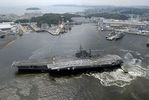
YOKOSUKA, Japan (May 28, 2008) Sailors spell out "Sayonara" on the flight deck of the aircraft carrier USS Kitty Hawk (CV 63) as the ship departs Yokosuka, Japan for the final time.YOKOSUKA, Japan (May 28, 2008) Sailors spell out "Sayonara" on the flight deck of the aircraft carrier USS Kitty Hawk (CV 63) as the ship departs Yokosuka, Japan for the final time. Sayonara is Japanese for "goodbye." Kitty Hawk will be replaced by the nuclear-powered aircraft carier USS George Washington (CVN 73). U.S. Navy photo by Mass Communication Specialist 3rd Class Kyle D. Gahlau (Released
|
|
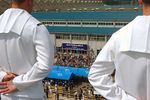
Sailors watch the pier while manning the rails aboard the aircraft carrier USS Kitty Hawk (CV 63) during the ship's final departure from Fleet Activities Yokosuka.YOKOSUKA, Japan (May 28, 2008) Sailors watch the pier while manning the rails aboard the aircraft carrier USS Kitty Hawk (CV 63) during the ship's final departure from Fleet Activities Yokosuka. Kitty Hawk is returning to the United States for decommissioning after 10 years of service in Fleet Activities Yokosuka and will soon be relieved by the Nimitz-class nuclear-powered aircraft carrier USS George Washington (CVN 73). U.S. Navy photo by Mass Communication Specialist Seaman Brendan Morgan (Released)
|
|
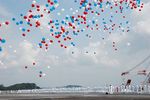
Sailors man the rails of the aircraft carrier USS Kitty Hawk (CV 63) as balloons are released from the flight deck. Kitty Hawk is returning to the United States for decommissioning after 10 years of service in Fleet Activities Yokosuka.YOKOSUKA, Japan (May 28, 2008) Sailors man the rails of the aircraft carrier USS Kitty Hawk (CV 63) as balloons are released from the flight deck. Kitty Hawk is returning to the United States for decommissioning after 10 years of service in Fleet Activities Yokosuka and will soon be relieved by the Nimitz-class nuclear-powered aircraft carrier USS George Washington (CVN 73). U.S. Navy photo by Mass Communication Specialist Seaman Brendan Morgan (Released)
|
|

SAN DIEGO (Aug. 7, 2008) The aircraft carrier USS Kitty Hawk (CV 63) moves past the nuclear-powered aircraft carrier USS George Washington (CVN 73), in background, as Kitty Hawk prepares to moor at Naval Air Station North Island, San Diego.SAN DIEGO (Aug. 7, 2008) The aircraft carrier USS Kitty Hawk (CV 63) moves past the nuclear-powered aircraft carrier USS George Washington (CVN 73), in background, as Kitty Hawk prepares to moor at Naval Air Station North Island upon her return to San Diego Thursday, Aug. 7, 2008. Kitty Hawk will be decommissioned next year in Bremerton, Wash. The 46- year-old carrier is the oldest active-duty warship in the Navy and will be replaced this summer George Washington as the Navy's only permanently forward-deployed aircraft carrier. (U.S. Navy photo by Mass Communication Specialist 3rd Class Kyle D. Gahlau/Released)
|
|
|
|
|
|
|